Module 4 summarizes the content from the first three modules and adds information related to the urinary catheter “life cycle” and some easy-to-remember steps related to CAUTI prevention.
Time required: 4 minutes
Potential Questions To Ask Before You Begin
- How much does the learner remember from modules 1–3? Can he/she summarize those modules in a few sentences for each?
Content Delivery Instructions
- Note that no slides contain instructions to stop the video.
Module 4 Content
Slide 1: Preventing CAUTI in the ICU Setting
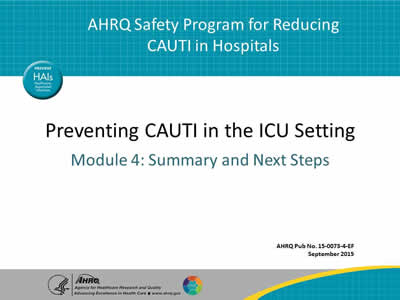
Narration:
- None
Potential points for discussion or questions from the learner:
- None
Slide 2: Summary of Module 1
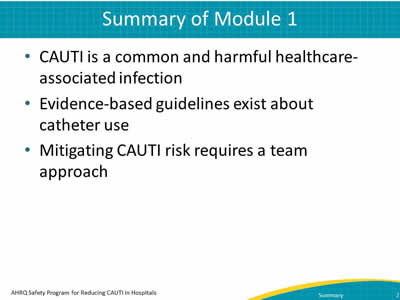
Narration:
You’ve now seen three modules on how to stop catheter-associated urinary tract infections, or CAUTI, in your intensive care unit, or ICU. In Module 1, you learned that hospital-acquired urinary tract infections impact almost 560,000 people every year in the United States alone. Of that number, almost 75 percent are catheter associated. Furthermore, of all healthcare-associated infections reported in the ICU, CAUTI accounts for nearly one-quarter of the infections.
You also learned in Module 1 that very clear, evidence-based guidelines exist about catheter use. In addition, you learned about the influence of unit culture on practice change and the importance of a team approach to reduce CAUTI.
Potential points for discussion or questions from the learner:
- Ask the learner if he/she has any questions about Module 1.
Slide 3: Summary of Module 2
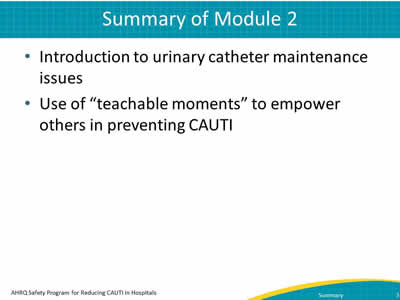
Narration:
Module 2 was about urinary catheter maintenance, and it featured the scenario of the nurse and the transporter. In it, you learned about aspects of catheter maintenance that can help prevent CAUTI, including bag placement and use of securement devices. You also learned about the power of teachable moments related to catheter use.
Potential points for discussion or questions from the learner:
- Ask the learner if he/she had any questions about this module.
Slide 4: Summary of Module 3
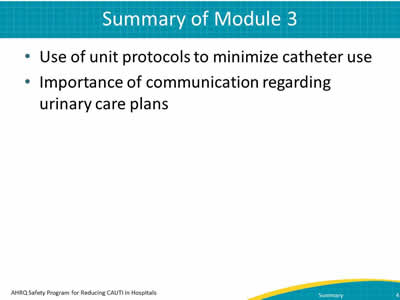
Narration:
Module 3 featured the interaction between a day-shift nurse and night-shift nurse around an elderly patient with a catheter. It highlighted the use of unit protocols related to catheter use. Even more importantly, it emphasized the importance of communication. Being sure that you foster communication between nurses and doctors or between shifts will help you reduce and ultimately eliminate CAUTI.
Potential points for discussion or questions from the learner:
- Does the learner have any questions about Module 3?
Slide 5: Evidence-Based Guidelines and CAUTI Prevention1
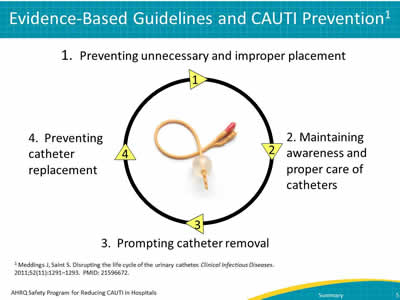
Narration:
In the first three modules, you learned a great deal about catheter use and its impact on CAUTI. This graphic summarizes many of the points at which you can impact catheter use. Ultimately, breaking the catheter life cycle disrupts the progression toward CAUTI.
First, try not to use a catheter at all. Prevent unnecessary and improper placement.
Second, if a catheter is used, maintain awareness and proper care of catheters already in place.
Third, promote prompt catheter removal. You can do this through catheter reminders and stop-orders.
Fourth, prevent catheter replacement.
Potential points for discussion or questions from the learner:
- Although this is a new image, the learner has seen the information elsewhere in the presentation. Is there anything contained in the image that the learner found new or confusing?
- What does the learner think about the image? How could it impact his/her work?
Slide 6: CAUTI Prevention, as Easy as ABCDE2
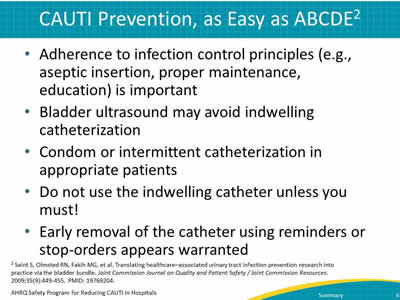
Narration:
When thinking about ways to break the catheter life cycle, consider these ABCDE prevention strategies:
- A, for adhering to sound infection prevention principles when using catheters
- B, for using equipment like the bladder ultrasound to assess patients’ ability to void adequately
- C, for thinking about alternatives to an indwelling urinary catheter like condom or intermittent catheterization
- D, meaning don’t use an indwelling catheter in the first place, if you can avoid it
- E, for removing the catheter as early as possible
Potential points for discussion or questions from the learner:
- As with the previous slide, the information on this slide has been presented elsewhere, but is merely summarized in a different way. Is there anything on this slide that especially interests the learner?
Slide 7: Your Challenge
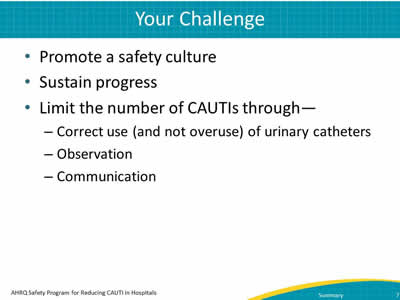
Narration:
Obviously, we all want to care for our patients. We have to view preventing CAUTI as part of that responsibility. Promote a culture in your ICU that emphasizes constant vigilance around safety and ending CAUTI.
Once you have helped contribute to that safety culture, you will need to sustain your progress. Sometimes, sustaining progress can be the hardest part. As things become routine or part of the way of doing business, attention to them can slip, and you go back to old routines. Fight that urge and help your unit maintain its commitment to excellence.
Above all, remember that you can limit the number of CAUTIs directly, through a few key ways:
- Use urinary catheters correctly. Avoid overuse.
- Observe what happens in your unit and how catheters are used. Step in to make sure they are used correctly.
- Communicate with others from both inside and outside your unit.
You can make a difference in CAUTI reduction and elimination.
Potential points for discussion or questions from the learner:
- How does the learner think he or she could contribute to creating a safety culture?
- What about sustaining progress related to CAUTI?



